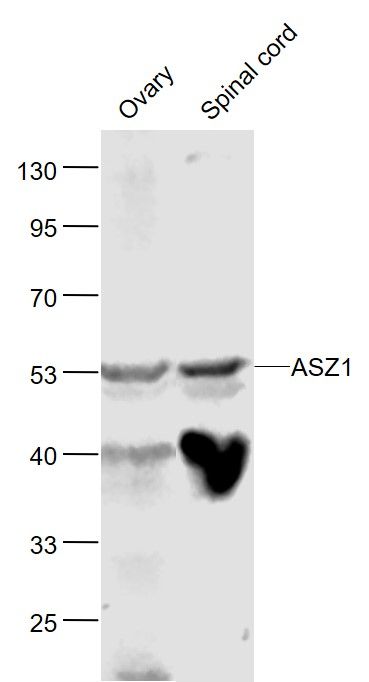ASZ1 Polyclonal Antibody
Purified Rabbit Polyclonal Antibody (Pab)
- SPECIFICATION
- CITATIONS
- PROTOCOLS
- BACKGROUND

Application
| WB, IHC-P, IHC-F, IF, E |
|---|---|
| Primary Accession | Q8WWH4 |
| Reactivity | Rat |
| Host | Rabbit |
| Clonality | Polyclonal |
| Calculated MW | 53 KDa |
| Physical State | Liquid |
| Immunogen | KLH conjugated synthetic peptide derived from human ASZ1 |
| Epitope Specificity | 151-250/475 |
| Isotype | IgG |
| Purity | affinity purified by Protein A |
| Buffer | 0.01M TBS (pH7.4) with 1% BSA, 0.02% Proclin300 and 50% Glycerol. |
| SUBCELLULAR LOCATION | Cytoplasm (By similarity). Note=Component of the meiotic nuage, also named P granule, a germ-cell-specific organelle required to repress transposon during meiosis. Specifically localizes to pi-bodies, a subset of the nuage which contains primary piRNAs (By similarity). |
| SIMILARITY | Contains 6 ANK repeats. Contains 1 SAM (sterile alpha motif) domain. |
| SUBUNIT | Interacts with DDX4, PIWIL1, RANBP9 and TDRD1 (By similarity). |
| Important Note | This product as supplied is intended for research use only, not for use in human, therapeutic or diagnostic applications. |
| Background Descriptions | ASZ1 (ankyrin repeat, SAM and basic leucine zipper domain-containing protein 1), also known as ANKL1, ALP1 (Ankyrin-like protein 1), GASZ (germ cell-specific ankyrin, SAM and basic leucine zipper domain-containing protein) or Orf3, is a 475 amino acid protein that is suggested to function as a signal transducer during germ cell maturation. Localized to the cytoplasm of pachytene spermatocytes, early spermatids and oocytes, ASZ1 is primarily found in adult testis and ovary where it mediates protein-protein interactions. ASZ1 contains six ANK repeats, one SAM (sterile alpha motif) domain and is encoded by a gene located on human chromosome 7q31, a region that may have an important role in the development certain types of human cancer. |
| Gene ID | 136991 |
|---|---|
| Other Names | Ankyrin repeat, SAM and basic leucine zipper domain-containing protein 1, Ankyrin-like protein 1, Germ cell-specific ankyrin, SAM and basic leucine zipper domain-containing protein, ASZ1 (HGNC:1350) |
| Target/Specificity | Expressed exclusively in the testis and ovary and at higher levels in the adult testis compared with the adult ovary. |
| Dilution | WB=1:500-2000,IHC-P=1:100-500,IHC-F=1:100-500,IF=1:50-200,ELISA=1:5000-10000 |
| Storage | Store at -20 ℃ for one year. Avoid repeated freeze/thaw cycles. When reconstituted in sterile pH 7.4 0.01M PBS or diluent of antibody the antibody is stable for at least two weeks at 2-4 ℃. |
| Name | ASZ1 (HGNC:1350) |
|---|---|
| Function | Plays a central role during spermatogenesis by repressing transposable elements and preventing their mobilization, which is essential for the germline integrity. Acts via the piRNA metabolic process, which mediates the repression of transposable elements during meiosis by forming complexes composed of piRNAs and Piwi proteins and governs the methylation and subsequent repression of transposons. Its association with pi-bodies suggests a participation in the primary piRNAs metabolic process. Required prior to the pachytene stage to facilitate the production of multiple types of piRNAs, including those associated with repeats involved in the regulation of retrotransposons. May act by mediating protein-protein interactions during germ cell maturation (By similarity). |
| Cellular Location | Cytoplasm. Note=Component of the meiotic nuage, also named P granule, a germ-cell-specific organelle required to repress transposon activity during meiosis. Specifically localizes to pi-bodies, a subset of the nuage which contains primary piRNAs (By similarity). |
| Tissue Location | Expressed exclusively in the testis and ovary and at higher levels in the adult testis compared with the adult ovary |

Thousands of laboratories across the world have published research that depended on the performance of antibodies from Abcepta to advance their research. Check out links to articles that cite our products in major peer-reviewed journals, organized by research category.
info@abcepta.com, and receive a free "I Love Antibodies" mug.
Provided below are standard protocols that you may find useful for product applications.
If you have used an Abcepta product and would like to share how it has performed, please click on the "Submit Review" button and provide the requested information. Our staff will examine and post your review and contact you if needed.
If you have any additional inquiries please email technical services at tech@abcepta.com.













 Foundational characteristics of cancer include proliferation, angiogenesis, migration, evasion of apoptosis, and cellular immortality. Find key markers for these cellular processes and antibodies to detect them.
Foundational characteristics of cancer include proliferation, angiogenesis, migration, evasion of apoptosis, and cellular immortality. Find key markers for these cellular processes and antibodies to detect them. The SUMOplot™ Analysis Program predicts and scores sumoylation sites in your protein. SUMOylation is a post-translational modification involved in various cellular processes, such as nuclear-cytosolic transport, transcriptional regulation, apoptosis, protein stability, response to stress, and progression through the cell cycle.
The SUMOplot™ Analysis Program predicts and scores sumoylation sites in your protein. SUMOylation is a post-translational modification involved in various cellular processes, such as nuclear-cytosolic transport, transcriptional regulation, apoptosis, protein stability, response to stress, and progression through the cell cycle. The Autophagy Receptor Motif Plotter predicts and scores autophagy receptor binding sites in your protein. Identifying proteins connected to this pathway is critical to understanding the role of autophagy in physiological as well as pathological processes such as development, differentiation, neurodegenerative diseases, stress, infection, and cancer.
The Autophagy Receptor Motif Plotter predicts and scores autophagy receptor binding sites in your protein. Identifying proteins connected to this pathway is critical to understanding the role of autophagy in physiological as well as pathological processes such as development, differentiation, neurodegenerative diseases, stress, infection, and cancer.


